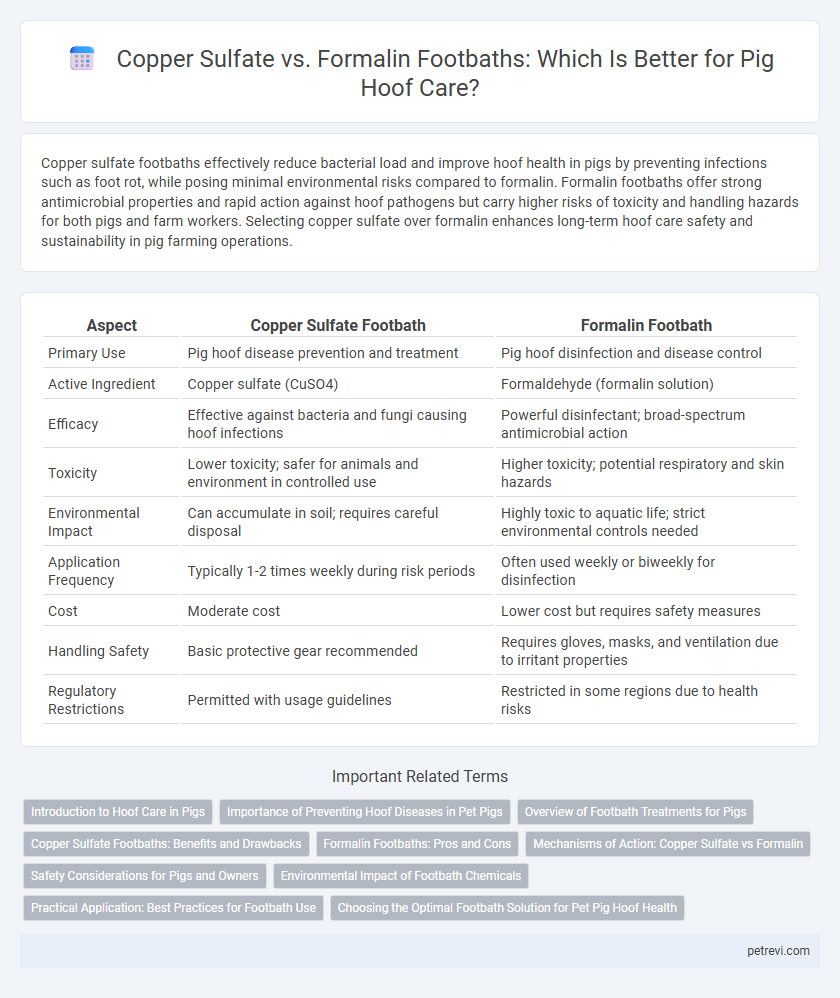Copper sulfate footbaths effectively reduce bacterial load and improve hoof health in pigs by preventing infections such as foot rot, while posing minimal environmental risks compared to formalin. Formalin footbaths offer strong antimicrobial properties and rapid action against hoof pathogens but carry higher risks of toxicity and handling hazards for both pigs and farm workers. Selecting copper sulfate over formalin enhances long-term hoof care safety and sustainability in pig farming operations.
Table of Comparison
| Aspect | Copper Sulfate Footbath | Formalin Footbath |
|---|---|---|
| Primary Use | Pig hoof disease prevention and treatment | Pig hoof disinfection and disease control |
| Active Ingredient | Copper sulfate (CuSO4) | Formaldehyde (formalin solution) |
| Efficacy | Effective against bacteria and fungi causing hoof infections | Powerful disinfectant; broad-spectrum antimicrobial action |
| Toxicity | Lower toxicity; safer for animals and environment in controlled use | Higher toxicity; potential respiratory and skin hazards |
| Environmental Impact | Can accumulate in soil; requires careful disposal | Highly toxic to aquatic life; strict environmental controls needed |
| Application Frequency | Typically 1-2 times weekly during risk periods | Often used weekly or biweekly for disinfection |
| Cost | Moderate cost | Lower cost but requires safety measures |
| Handling Safety | Basic protective gear recommended | Requires gloves, masks, and ventilation due to irritant properties |
| Regulatory Restrictions | Permitted with usage guidelines | Restricted in some regions due to health risks |
Introduction to Hoof Care in Pigs
Copper sulfate footbaths are widely used in pig hoof care due to their effective antimicrobial properties, targeting bacteria that cause hoof infections such as digital dermatitis. Formalin footbaths also provide strong disinfectant action but pose higher risks due to formaldehyde's toxicity and environmental concerns. Proper hoof care using these solutions helps prevent lameness and improves overall swine welfare and productivity.
Importance of Preventing Hoof Diseases in Pet Pigs
Copper sulfate footbaths provide effective antimicrobial action against common hoof pathogens in pet pigs, reducing the risk of infectious diseases like digital dermatitis and foot rot. Formalin footbaths also exhibit strong disinfectant properties but require careful handling due to toxicity concerns, making copper sulfate a safer alternative for routine hoof care. Preventing hoof diseases through regular footbaths maintains mobility and overall health in pet pigs, crucial for their welfare and longevity.
Overview of Footbath Treatments for Pigs
Copper sulfate footbaths are effective in controlling bacterial infections and reducing hoof lesions in pigs by providing antifungal and antibacterial properties. Formalin footbaths offer strong disinfectant action against pathogens but pose higher risks of toxicity and environmental hazards. Both treatments target hoof health in pigs, with copper sulfate favored for safety and long-term hoof protection.
Copper Sulfate Footbaths: Benefits and Drawbacks
Copper sulfate footbaths in pig hoof care are effective in controlling bacterial and fungal infections, reducing the incidence of foot lesions and improving overall hoof health. They provide a cost-efficient solution with antimicrobial properties, but prolonged use can cause environmental concerns due to copper accumulation and potential toxicity to animals. Proper management and monitoring are essential to balance the benefits of copper sulfate with its ecological impact.
Formalin Footbaths: Pros and Cons
Formalin footbaths offer effective control of bacterial and fungal infections in pig hooves, reducing the incidence of foot rot and improving overall herd health. However, their use poses significant health risks due to formalin's toxicity and carcinogenic potential, requiring strict safety protocols and ventilation during application. While formalin footbaths provide strong antimicrobial action, alternative treatments with lower toxicity, like copper sulfate, are often preferred for safer long-term hoof care management in pigs.
Mechanisms of Action: Copper Sulfate vs Formalin
Copper sulfate footbaths function by releasing copper ions that disrupt bacterial cell membranes and inhibit enzymatic processes, effectively reducing hoof pathogens in pigs. Formalin footbaths work by denaturing proteins and nucleic acids within microbial cells, leading to rapid disinfection and tissue preservation. Both compounds target different microbial vulnerabilities, with copper sulfate providing sustained antimicrobial activity and formalin delivering immediate bactericidal effects in pig hoof care.
Safety Considerations for Pigs and Owners
Copper sulfate footbaths offer effective antimicrobial properties for pig hoof care but pose risks of environmental toxicity and skin irritation, requiring careful handling and disposal. Formalin footbaths provide strong disinfectant power but contain formaldehyde, a hazardous chemical that can cause respiratory issues and skin burns in both pigs and handlers. Safe usage protocols and protective equipment are essential to minimize health risks for pigs and farm workers when using either footbath solution.
Environmental Impact of Footbath Chemicals
Copper sulfate footbaths release heavy metals into the environment, posing risks of soil and water contamination that can harm aquatic life and microbial ecosystems. Formalin footbaths, containing formaldehyde, contribute to air and water pollution with carcinogenic compounds, raising concerns about operator safety and environmental persistence. Sustainable pig hoof care favors alternatives with lower toxicity and better biodegradability to minimize ecological damage.
Practical Application: Best Practices for Footbath Use
Copper sulfate footbaths for pig hoof care require regular monitoring of concentration levels, typically maintained at 5%, to effectively reduce bacterial load and prevent lesions. Formalin footbaths, often used at 3-5% concentration, demand careful handling due to toxicity risks, with strict protocols for ventilation and protective equipment to ensure safety. Best practices emphasize routine footbath renewal, appropriate depth to fully immerse hooves, and consistent cleaning schedules to maximize therapeutic benefits and minimize environmental impact.
Choosing the Optimal Footbath Solution for Pet Pig Hoof Health
Copper sulfate footbaths offer effective control against bacterial infections and are favored for their antimicrobial properties, promoting healthy hooves in pet pigs. Formalin footbaths provide a strong disinfectant action but pose higher toxicity risks and require careful handling to avoid adverse effects. Selecting an optimal footbath solution depends on balancing efficacy, safety, and environmental impact to maintain pig hoof health while minimizing health hazards.
Copper sulfate footbath vs Formalin footbath for Pig hoof care Infographic

 petrevi.com
petrevi.com